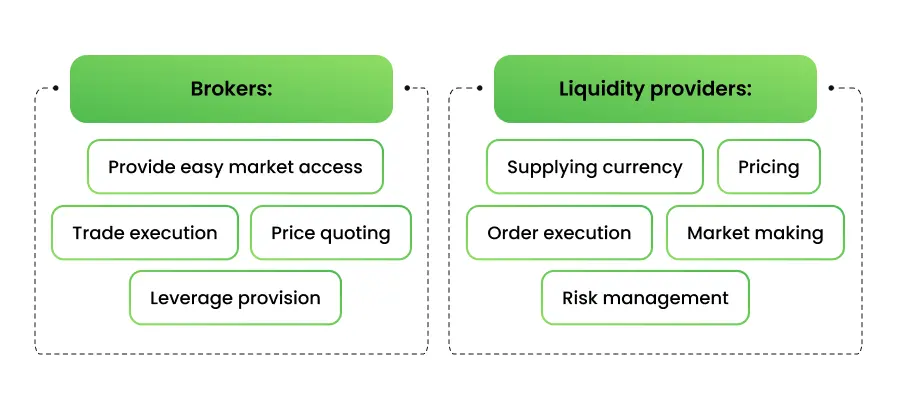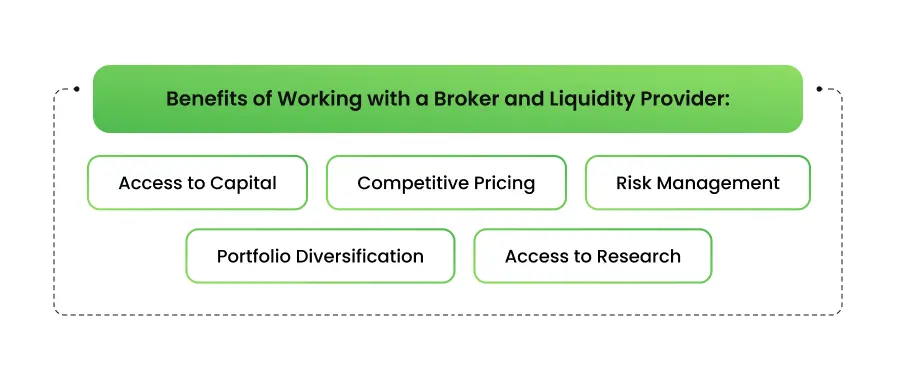How do Brokers and Liquidity Providers Work Together?
- Introduction
- Brokers
- Liquidity providers
- How Brokers and Liquidity Providers Work Together
- Collaboration examples between brokers and liquidity providers
- Benefits for both parties
- Benefits of Working with a Broker and Liquidity Provider
- Conclusion
- FAQs
Introduction
There are two key players you can't bypass in the foreign exchange (FX) market, the liquidity providers and brokers. These parties' collaboration ensures a liquid and efficient FX market for traders.
Liquidity providers ensure that the market has tradable currency pairs and provide pricing information. While brokers link traders to liquidity providers and execute trades on behalf of the traders.
In this blog post, we'll shed more light on how these parties work together to ease trading and provide you with a deeper understanding of the interplay between these parties and the impact it has on trading activities.

Brokers
Brokers are individuals or companies who represent traders to buy and sell assets. Think of them as intermediaries, facilitating transactions between traders and LPs. Without them, traders would encounter difficulty with transactions and the smooth flow of trade. Every broker needs to obtain a license. They are regulated by financial regulatory bodies, there are over 100 regulatory bodies globally, these bodies have differing degrees of focus and authority. In the US there's the Securities and Exchange Commission (SEC), in Europe, there's the European Securities and Markets Authority (ESMA), and in the UK there's the Financial Conduct Authority.
Their key roles in the market can be classified into these four functions.
Provide easy market access. Online brokers help to make markets easily accessible, they offer traders an accessible environment or a trading platform to easily exchange assets. Their absence would lead to difficulty in participating in trading activities.
Trade execution. They are tasked with finding counterparties for traders, they also make sure the trades executed are done at a favourable market price.
Leverage provision. They offer leverage to allow traders to operate with more capital than they have. This could amplify potential returns— gains or losses.
Price quoting. Through specialized software, brokers monitor the market and give clients real-time and accurate pricing information.
Liquidity providers
Liquidity providers (or liquidity suppliers) are financial bodies that hold large pools of assets and supply the needed liquidity. When LPs provide or increase liquidity for brokers and the market, trading costs are reduced, in return it provides a positive impact on the financial market.
The key roles of liquidity providers in the market can be classified into these five (5) functions;
Supplying currency. LPs provide a pool of assets (stocks, currencies, etc.) open for buying and selling, ensuring smooth transactions without significant price fluctuations.
Pricing. LPs continually quote bids and ask prices, they act as market makers and set reference points for other participants. This transparency facilitates efficient price discovery.
Order execution. LPs fulfil buy and sell orders promptly, even in high-volume conditions. This permits traders to enter and exit positions quickly and efficiently.
Risk management. LPs minimize market risk by taking the opposite side of trades, mitigating volatility and ensuring market stability. They protect both themselves and other participants.
Market making. LPs proactively add orders to the order book, even when there's no immediate buyer or seller, this ensures continuous market activity and facilitate smoother price discovery.
How Brokers and Liquidity Providers Work Together
The collaboration between these parties can be viewed as a symbiotic dance, we have classified this dance into four facets.
The broker seeks liquidity. Whenever a trader places an order with a broker, the broker requires a counterparty to execute it. This is when they reach out to their network of LPs to seek the best price and execution for their client.
The LP meets the demand. As soon as the LP is contacted, the LP analyze the order and market conditions. If the order can be profitably fulfilled they agree to act as the counterparty, that is to buy or sell the asset.
Trade execution. After the parties agree, the broker forwards the LP's offer to the trader. Once the price and terms are satisfactory, the trade is executed, and the asset is moved.
Sharing the pie. To sum up the symbiotic dance, each party take their share of the earned fee. Online brokers charge the trader a commission while LPs earn profits when they buy or sell assets at profitable prices. No losses, each party goes home happy.
Collaboration examples between brokers and liquidity providers
We have given three examples to illustrate the collaboration between these parties.
ECN Brokers. Electronic Communication Networks (ECNs) connect traders to numerous LPs, they offer competitive prices and transparent execution.
Market Maker Model. Here the broker itself acts as the LP, in this model, the broker takes the opposite side of the trade. This model proposes faster execution however, it raises possible conflicts of interest.
Hybrid Models. Brokers can blend components of the previous models, they offer ECN access for some assets while they front as market makers for other traders.
Benefits for both parties
When both parties are on the same page, the relationship between the two is usually beneficial.
For the brokers.
Access to Liquidity. A partnership with LPs makes it easier for brokers to fulfil various trade proposals, bringing in more clients and improving their business.
Competitive Pricing. When online brokers access multiple LPs, they can offer competitive prices to traders which enhances increased customer satisfaction and loyalty.
Efficiency. To streamline trade execution, automated systems and technology facilitate rapid and seamless communication between brokers and LPs.
For LPs.
Increased Trading Volume. These parties' partnership expands their reach to more prospective buyers and sellers, this helps to boost trading volume and profitability.
Diversification. When LPs spread their assets across numerous brokers and markets they can diversify financial risk.
Reduced Costs. These parties' collaboration could reduce the LP's organizational duties and expenditures tied to controlling individual orders.
Benefits of Working with a Broker and Liquidity Provider
The partnership between these parties results into numerous benefits to traders, it enables them to navigate complicated markets with improved efficiency and profitability. Let's dive into the key areas where this collaboration shines.
Access to Capital. This partnership helps to expand the broker's capital base and allows them to offer bigger trade sizes and cater to institutional clients with significant investment needs. It also broadens LPs' reach through verified broker networks, hereby granting the LPs access to a wider puddle of potential clients.
Competitive Pricing. Brokers' partnerships with LPs offer competitive prices as they can leverage beneficial rates to attract clients. Through brokers, LPs get restrained channels to reach clients who trade with larger volumes thereby generating more fees. This motivates the LPs to offer competitive rates to secure a valuable partnership.
Risk Management. When brokers partner with reputed LPs it enhances overall financial stability and their clients are secure and rest assured. LPs partnership with broker allows them to manage their positions and exposure more effectively and this leads to a stable and efficient market.
Portfolio Diversification. Brokers' partnership with different LPs grants access to a wider range of assets and instruments which allows brokers to offer various investment options to their clients. LPs' partnership with brokers helps them access exposure to untouched asset classes, which enables them to expand their reach.
Access to Research. LPs give access to high-quality research and market analysis. When brokers leverage on this it offers valuable insights and investment guides they could offer their clients. When LPs partner with brokers they can disperse their research to a wider audience, strengthen their market presence, and attract new clients.

Conclusion
From this blog post, you have seen the way brokers and liquidity providers work together and the importance of their collaboration. Brokers provide easy market access, facilitate trade execution, offer leverage to allow buyers to operate, and monitor pricing to give price information. Liquidity providers supply currency to ensure smooth transactions, they quote bid and ask prices, act as market makers, execute orders efficiently, and minimize market risks.
Without their collaboration, there would be difficulty in making trading decisions. With the help of their collaboration traders can easily navigate the complicated market. They keep prices competitive, they grant easy access to capital and very importantly, they curb risks. To sum it up, as long as the brokers and LPs are on a good page, the traders and other stakeholders are in safe hands.
The Forex Broker Turnkey solution includes all the key components required for effective risk management in Forex brokerage firms, including a smart liquidity aggregator.
Frequently Asked Questions
Q1: What is the role of brokers in the Forex market?
Brokers act as intermediaries in the market. They connect traders to an expansive interbank market, they facilitate currency exchange and trade execution.
Q2: How does the collaboration between brokers and liquidity providers benefit traders?
The collaboration between brokers and LPs enhances market depth, ensures better pricing and lessens slippage.
Q3: Why is access to capital crucial for traders and investors in the Forex market?
Access to capital is crucial for traders and investors in the Forex market because it facilitates large trade sizes which could lead to larger returns. It provides flexibility to respond to market opportunities.
Q4: How do liquidity providers contribute to pricing in the market?
Liquidity providers could contribute to pricing by providing price quotes, contributing to the structure of market exchange rates.
Q5: What advantages does portfolio diversification offer to investors?
Portfolio diversification lessens overall risk by minimizing losses from unfavourable junctures in any single currency. They also spread exposure across various currencies and economies. And capitalize on opportunities in different markets which could boost returns.
Our team is ready to provide a detailed advice list on the basics of Forex broker risk management with the help of Soft-FX technologies.



